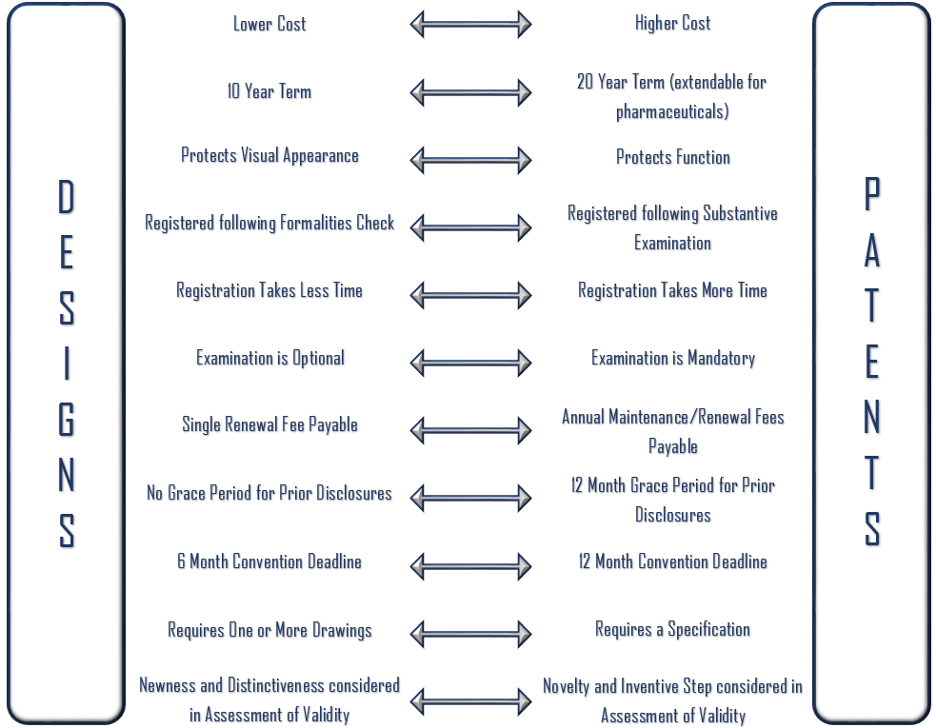It is a common belief that patents and designs share a similar legal basis, particularly as some jurisdictions, such as the United States, label an industrial design right as a "design patent". However, in Australia, design rights and patent rights are different in legal nature by virtue of separate legislations.
We highlight, in Figure 1 below, several key differences between Australian design rights and standard patent rights. Whilst there are clear differences, both legal rights may often be complementary in providing well-rounded protection for a unique commercial product.

Figure 1: Summary of several key differences between
Australian design rights and standard patent rights.
- Cost
-
In most instances, the cost to prepare and file an application for an Australian design is lower than for an Australian standard patent. One reason for this is that more professional time is usually involved in the preparation of a patent specification that accompanies the standard patent application. The specification typically involves a significant amount of written detail specifying the invention.
In contrast, a design application requires one or more representations to be prepared which illustrate the design to be protected. Whilst the representations do not require the same level of written detail as a patent specification, the representations need to be carefully prepared to ensure that the scope of design protection is appropriately maximised.
There are also discrepancies in cost due to the minimal prosecution effort required to obtain registration of a design application. This is because a design application in Australia is not subject to mandatory examination but instead, proceeds directly through to registration following compliance with formalities. By comparison, not only is it a requirement for a standard patent application to comply with formalities but it must also be substantively examined before being registered and granted.
Further reasons for the cost disparity between patents and designs are discussed below.
- Duration of protection
-
Perhaps as a trade-off for the generally lower cost to obtain a design right, a registered Australian design offers a shorter term of protection.
Currently, a design registration in Australia has a maximum term of protection of 10 years before the registration expires. This differs from a standard patent which has a maximum term of 20 years (which can be extended in certain circumstances for subject matter relating to 'pharmaceutical substances'). It is important to factor in this difference in the duration of protection when considering the development and commercialisation timeline of a product.
However, the term of an Australian design registration is currently under legislative review, with the Australian Government accepting the Advisory Council on Intellectual Property's (ACIP) recommendation to extend the maximum term of protection of designs to 15 years if Australia joins the Hague Agreement. This would more closely align Australia with foreign jurisdictions in respect to the duration of design rights.
- Form of Protection
-
Unlike a standard patent, a design registration does not provide protection in relation to the construction or function of a product. Instead, a design registration provides protection for the overall appearance of a product resulting from one or more visual features. The visual features may include a combination of pattern, colour, shape or configuration which creates a unique look. For example, the unique look of a smartphone may be protected by a design right whilst the way the smartphone works may be protected by a patent right.
- Registration
-
As noted above, an application for an Australian design proceeds directly through to registration following a check for formalities compliance. In contrast, an application for an Australian standard patent undergoes substantive examination before being registered and granted. This difference not only contributes to the cost disparity discussed previously, but also results in a shorter time period to achieve registration for a design application (which is typically a matter of months) as opposed to a longer time period to achieve registration and grant of a patent application (which is typically a matter of years).
- Examination and Enforceability
-
Examination of an Australian design registration is optional. However, the design registration cannot be enforced until the design has been examined and subsequently certified with the issuance of a Certificate of Examination following successful examination. Costs can therefore be delayed by requesting examination only when ready to enforce the design registration.
In contrast, examination of a standard patent application is mandatory. The patent application will be enforceable following successful examination (that is, acceptance or allowance) and subsequent granting of the Patent.
- Annuities
-
A further reason for the cost disparity between Australian patents and designs is that only a single renewal fee is payable for an Australian design registration. This renewal fee is payable five years after the filing date of the design.
By comparison, annual maintenance/renewal fees must be paid to keep a standard patent application/patent in force. These maintenance/renewal feels become payable annually from the fourth anniversary of the filing date until the application/patent ceases.
- Grace period
-
Currently1, there is no grace period provision for filing a design in Australia following a prior publication of that design. This means that any prior publication of that design (including by the design owner) before the filing of the corresponding design application is likely to be cited as prior art and may ultimately invalidate the subsequent registered design. It is therefore crucial that the design is retained as confidential and not commercially used prior to filing a corresponding design application.
In contrast, the Australian patent system provides a grace period in which a public disclosure of an invention must be disregarded from the prior art base, provided an application for a standard patent is filed within 12 months of public disclosure. Please keep in mind that special care should be taken if relying on the grace period as it is merely intended to act as a safety net in certain circumstances. Until the patent application is lodged, it is imperative to retain the invention as confidential and not commercially use the invention.
- Convention period
-
The Australian designs system provides that an applicant can maintain the filing date of their first filed Australian design application as the 'priority date' for a corresponding application filed in another Convention country, provided that the corresponding application is filed within six months of the Australian application. A similar provision exists for the Australian patent system except that the Convention period is 12 months. The longer Convention period may help to delay costs and provide more time to decide if foreign protection is desired.
- Contents of application
-
An application for an Australian design is accompanied by one or more representations which illustrate the design to be protected. The representations are typically in the form of drawings but may be photographs or digital images. The representations should show a consistent and complete picture of the design. Apart from view labels, product name and statement of newness and distinctiveness, no other descriptive text or written detail of the design is required as part of the application. We have prepared a checklist highlighting several considerations to keep in mind when preparing a design application.
On the other hand, a standard patent application requires a specification detailing the invention. The specification typically involves a significant amount of written detail and includes:
- a title,
- a description,
- one or more claims defining the invention,
- drawings, and
- an abstract.
A patent specification can be a lengthy and technical document and often requires more time and cost to prepare than preparing representations for a design application.
- Assessment of Validity
-
Validity of a design registration is considered during examination which determines whether the design is new and distinctive. This involves an assessment as to whether the registered design is identical to or substantially similar in overall impression to a prior art design. Several factors may influence this assessment such as giving more weight to similarities between the designs than their differences, having regard to the state of development of the prior art base for the design, and having particular regard to features mentioned in any statement of newness and distinctiveness.
In contrast, examination of a patent application and validity of a patent involves an assessment as to whether the invention:
- is a manner of manufacture,
- is novel and involves an inventive step compared with the prior art base,
- is useful, and
- was not secretly used.
Jurisprudence on the matters of patent validity is significantly more developed than on the matters of design validity, highlighting the mature nature of the patent system compared to the design system in Australia.
Whilst there are clear differences between Australian designs law and patent law, both legal rights may often be complementary in providing well-rounded protection for a unique commercial product.
If you would like any further information on protecting your design or invention in Australia, please contact us.
Footnote
1It is likely that the Australian Government will soon introduce a prior art grace period for the Australian designs system. See https://www.ipaustralia.gov.au/designs/design-initiatives for more information.
The content of this article is intended to provide a general guide to the subject matter. Specialist advice should be sought about your specific circumstances.


